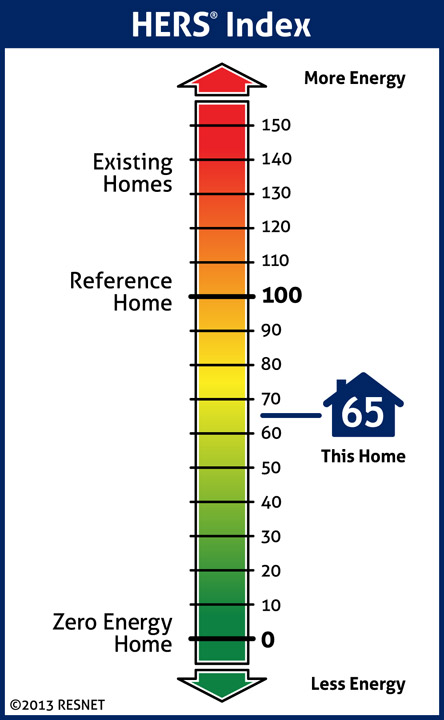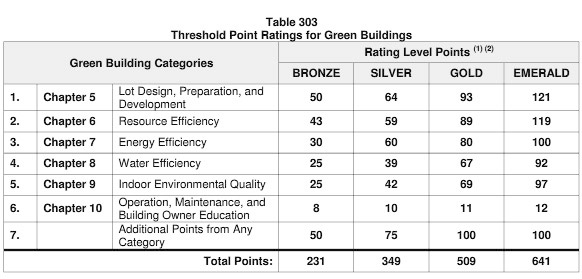Appliance Performance beyond ENERGY STAR®
Home Energy Rating System (HERS) by RESNET
The Residential Energy Services Network (RESNET) is an independent, not-for-profit member based organization primarily made up of certified home energy raters serving builders, contractors, and federal government agencies. The primary tool used for establishing an energy rating by this organization is the HERS Index which is a modeled estimation of total home energy use and cost compared to a baseline value. A certified RESNET HERS home rater assesses on site the many variables of a subject home including the size of the home, number of bedrooms, insulation levels, window types and sizes, climate region, and home orientation, as well as information on all the appliances, lighting, etc. To calculate the home’s HERS Index Score, the rater compares the data against a 'reference home'– a designed-model home of the same size and shape as the actual home, so the score is always relative to the size, shape and type of house being rated. A typical new, energy code compliant (based on 2006 version of the International Energy Conservation Code (IECC)) home is assigned a baseline value of 100 while a typical existing home today would have a baseline score a 130. So for example, a new home with a HERS Index score of 70 would be deemed to be 30 percent more efficient than a comparable baseline new home while a score of 130 in this case would be deemed 30 percnet less efficient.
 |
The HERS Index is used to establish a comparative score on energy efficiency for homes. Image courtesy of Whirlpool Corporation and RESNET |
Keep in mind that this index is all based on modeling, not actual performance - actual results will vary depending on the number of occupants, behavior, weather, etc. Nonetheless, the HERS Index has become an accepted methodology to estimate and communicate the energy efficiency of a home to prospective homebuyers. In terms of addressing appliances, there are baseline assumptions for old appliances in the model that are compared to the actual appliances installed in the house. Updating the old refrigerator, cooking appliance, dishwasher, washing machine, and dryer could reduce the HERS Index by 2 to 4 or more points, which would indicate a 2 to 4 percent more efficient home overall. HERS raters are also equipped to make recommendations on selecting the most appropriate energy efficient appliances for a particular home.
ICC700-2012: National Green Building Standard (formerly NAHB Green)
In 2007, the National Association of Home Builders (NAHB) and the International Code Council (ICC) partnered to create the 2008 NAHB Green Building Standard. The 2012 version referred to as the ICC700-2012 National Green Building Standard (NGBS) incorporates enhancements gleaned from its first four years of use. It also updates its baseline for energy performance to the 2009 version of the International Energy Conservation Construction Code (IECC). In January 2013, the NGBS was approved by the American National Standards Institute (ANSI) as an American National Standard.
The NGBS is a multi-attribute, point-based green standard specifically intended for residential buildings. It is broken down into 6 basic rating categories which include Lot Design, Resource Efficiency, Energy Efficiency, Water Efficiency, Indoor Environmental Quality, Operation, and Maintenance/ Building Owner Education. The seventh category of “Other” is an opportunity to earn additional points by acquiring points in any of the previous six by exceeding the minimum requirements in each category. Under this standard, a building can strive to achieve one of four rating levels based on the number of points earned:
Bronze level: 231 points needed
Silver level: 349 points needed
Gold level: 509 points needed
Emerald level: 641 points needed.
 |
The National Green Building Standard is broken down by 7 categories and is based on earning points within each of those categories to demonstrate a level of performance. Courtesy of Whirlpool Corporation |
Appliances are specifically covered under the Energy Efficiency category in Chapter 7 of the NGBS. This category allows for two different options to show compliance. If the “Performance Path” is selected, then the entire building needs to be modeled or rated similar to the HERS Index or other computer-modeling software. Then points are assigned based on the percentage of reduction compared to the 2009 IECC baseline. The other option is to use the “Prescriptive Path” whereby a checklist is used to show points being earned for specific items. In the case of appliances, if those installed are ENERGY STAR® rated then they can earn up to 3 points for a refrigerator (depending on climate zone location), 1 point for a dishwasher, 4 points for a washing machine, and 1 point for an induction cooktop. Under innovative practices, an additional point can be earned for using between three to five Smart Appliances and 2 points when six or more Smart Appliances are installed. Water conserving appliances are addressed in Chapter 8 under the Water Efficiency category. If the dishwasher and clothes washer are ENERGY STAR® rated then they can earn 2 and 13 points respectively since water usage, in addition to energy usage, is accounted for on those machines. If the clothes washer demonstrates a water factor of 6.0 or less, then the NGBS points jump from 13 to 24.
All told, appliances can contribute up to 37 possible points toward a final Prescriptive Path building rating – more than 10% of the Silver level requirement. A Performance Path model may achieve a different number of points, potentially more than the Prescriptive Path, and should be compared accordingly.









